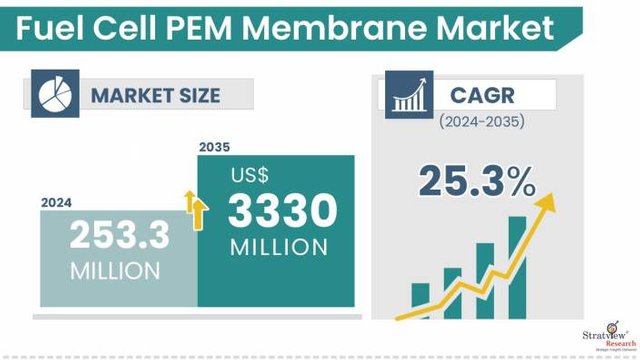Fuel Cell PEM Membranes: Powering the Transition to Clean Energy
A Clean Energy Revolution
In the ongoing battle against climate change, fuel cells powered by Proton Exchange Membranes (PEM) are emerging as key players. These fuel cells are critical for advancing sustainable energy solutions, offering a cleaner, more efficient alternative to traditional power sources. PEM fuel cells convert hydrogen into electricity, with water being the only byproduct — a significant advantage over fossil fuel combustion.
The Fuel Cell PEM Membrane Market is seeing exponential growth, driven by the push toward clean energy and decarbonization. According to Stratview Research, the global market for fuel cell PEM membranes is expected to grow at a CAGR of 25.3% from 2024 to 2035, reaching a market value of USD 3330.0 million by 2035.
Driving Forces Behind the Growth
Several factors are accelerating the growth of the Fuel Cell PEM Membrane market:
1. Electrification of Transportation: The automotive sector is one of the key areas where PEM fuel cells are making an impact. Hydrogen-powered vehicles, including cars, buses, and trucks, are gaining traction, especially in countries like Japan, Germany, and the U.S. Companies such as Toyota and Hyundai are leading the way with models like the Toyota Mirai and Hyundai Nexo. This shift towards hydrogen-powered vehicles is boosting demand for PEM membranes.
2. Government Policies and Incentives: Governments worldwide are setting ambitious targets to reduce carbon emissions and increase the use of renewable energy. For example, the European Union aims to reduce its carbon footprint by 55% by 2030. Many countries are supporting the hydrogen economy through subsidies and incentives for fuel cell technology.
3. Hydrogen Infrastructure Development: As more hydrogen refueling stations are built, the adoption of PEM fuel cells is set to rise. Hydrogen is becoming more accessible, enabling fuel cell vehicles to operate efficiently in urban centers and across regions.
Technological Innovations Driving PEM Fuel Cells
Recent advancements in PEM fuel cell technology are making them more efficient and affordable. For instance:
• Non-precious metal catalysts are being developed to replace expensive platinum catalysts, reducing the overall cost of PEM fuel cells.
• New membrane materials are being researched to improve durability and performance, particularly at higher temperatures and pressures.
Download the sample report here, to uncover in-depth insights:
https://stratviewresearch.com/Request-Sample/3963/fuel-cell-pem-membrane-market.html#form
Challenges Facing the Market
Despite the promising growth, there are challenges:
• Cost of PEM fuel cells remains high, especially for the automotive sector, where the cost of hydrogen fuel and the production of fuel cells themselves needs to be reduced.
• Hydrogen production and storage remain bottlenecks, as the majority of hydrogen is currently produced from natural gas, which is not entirely green.
Looking Ahead: The Future of PEM Fuel Cells
The future of the Fuel Cell PEM Membrane market is bright, with the increasing focus on hydrogen as a clean energy source. As costs decrease and technologies improve, PEM fuel cells will play an essential role in the global energy transition, powering everything from vehicles to industrial applications.
